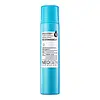What's inside
What's inside
 Key Ingredients
Key Ingredients

 Benefits
Benefits

 Concerns
Concerns

 Ingredients Side-by-side
Ingredients Side-by-side

Water
Skin ConditioningAlcohol Denat.
AntimicrobialDipropylene Glycol
HumectantGlycerin
HumectantNiacinamide
SmoothingAdenosine
Skin ConditioningAllantoin
Skin ConditioningAscorbic Acid
AntioxidantCentella Asiatica Extract
CleansingAllium Cepa Bulb Extract
Skin ConditioningTuber Magnatum Extract
Skin ConditioningOlea Europaea Fruit Oil
MaskingPelargonium Graveolens Flower Oil
MaskingMentha Piperita Oil
MaskingCitrus Aurantium Dulcis Oil
MaskingChamomilla Recutita Flower Oil
MaskingRose Flower Oil
MaskingCitrus Aurantium Bergamia Fruit Oil
MaskingLavandula Hybrida Oil
EmollientCyclopentasiloxane
EmollientCyclohexasiloxane
EmollientPEG-60 Hydrogenated Castor Oil
EmulsifyingButylene Glycol
HumectantMadecassoside
Antioxidant1,2-Hexanediol
Skin ConditioningEthylhexylglycerin
Skin ConditioningPhenoxyethanol
PreservativeDisodium EDTA
Water, Alcohol Denat., Dipropylene Glycol, Glycerin, Niacinamide, Adenosine, Allantoin, Ascorbic Acid, Centella Asiatica Extract, Allium Cepa Bulb Extract, Tuber Magnatum Extract, Olea Europaea Fruit Oil, Pelargonium Graveolens Flower Oil, Mentha Piperita Oil, Citrus Aurantium Dulcis Oil, Chamomilla Recutita Flower Oil, Rose Flower Oil, Citrus Aurantium Bergamia Fruit Oil, Lavandula Hybrida Oil, Cyclopentasiloxane, Cyclohexasiloxane, PEG-60 Hydrogenated Castor Oil, Butylene Glycol, Madecassoside, 1,2-Hexanediol, Ethylhexylglycerin, Phenoxyethanol, Disodium EDTA
Bambusa Vulgaris Water
Skin ConditioningWater
Skin ConditioningButylene Glycol
HumectantCetyl Ethylhexanoate
Emollient1,2-Hexanediol
Skin ConditioningGlycerin
HumectantTrehalose
HumectantSimmondsia Chinensis Seed Oil
EmollientCocos Nucifera Oil
MaskingVincetoxicum Atratum Extract
Skin ConditioningScutellaria Baicalensis Root Extract
AstringentLonicera Japonica Flower Extract
Skin ConditioningForsythia Suspensa Fruit Extract
AntioxidantBambusa Vulgaris Extract
Skin ConditioningPinus Densiflora Extract
AntioxidantThuja Orientalis Extract
AntimicrobialChamaecyparis Obtusa Leaf Extract
Skin ConditioningSodium Hyaluronate Crosspolymer
HumectantHyaluronic Acid
HumectantHydroxypropyltrimonium Hyaluronate
Sodium Hyaluronate
HumectantHydrolyzed Hyaluronic Acid
HumectantHydrolyzed Sodium Hyaluronate
Skin ConditioningPentylene Glycol
Skin ConditioningGlyceryl Stearate Citrate
EmollientPolyglyceryl-3 Distearate
EmulsifyingCetearyl Alcohol
EmollientCarbomer
Emulsion StabilisingTromethamine
BufferingDisodium EDTA
Bambusa Vulgaris Water, Water, Butylene Glycol, Cetyl Ethylhexanoate, 1,2-Hexanediol, Glycerin, Trehalose, Simmondsia Chinensis Seed Oil, Cocos Nucifera Oil, Vincetoxicum Atratum Extract, Scutellaria Baicalensis Root Extract, Lonicera Japonica Flower Extract, Forsythia Suspensa Fruit Extract, Bambusa Vulgaris Extract, Pinus Densiflora Extract, Thuja Orientalis Extract, Chamaecyparis Obtusa Leaf Extract, Sodium Hyaluronate Crosspolymer, Hyaluronic Acid, Hydroxypropyltrimonium Hyaluronate, Sodium Hyaluronate, Hydrolyzed Hyaluronic Acid, Hydrolyzed Sodium Hyaluronate, Pentylene Glycol, Glyceryl Stearate Citrate, Polyglyceryl-3 Distearate, Cetearyl Alcohol, Carbomer, Tromethamine, Disodium EDTA
Ingredients Explained
These ingredients are found in both products.
Ingredients higher up in an ingredient list are typically present in a larger amount.
1,2-Hexanediol is a synthetic liquid and another multi-functional powerhouse.
It is a:
- Humectant, drawing moisture into the skin
- Emollient, helping to soften skin
- Solvent, dispersing and stabilizing formulas
- Preservative booster, enhancing the antimicrobial activity of other preservatives
Butylene Glycol (or BG) is used within cosmetic products for a few different reasons:
Overall, Butylene Glycol is a safe and well-rounded ingredient that works well with other ingredients.
Though this ingredient works well with most skin types, some people with sensitive skin may experience a reaction such as allergic rashes, closed comedones, or itchiness.
Learn more about Butylene GlycolDisodium EDTA plays a role in making products more stable by aiding other preservatives.
It is a chelating agent, meaning it neutralizes metal ions that may be found in a product.
Disodium EDTA is a salt of edetic acid and is found to be safe in cosmetic ingredients.
Learn more about Disodium EDTAGlycerin is already naturally found in your skin. It helps moisturize and protect your skin.
A study from 2016 found glycerin to be more effective as a humectant than AHAs and hyaluronic acid.
As a humectant, it helps the skin stay hydrated by pulling moisture to your skin. The low molecular weight of glycerin allows it to pull moisture into the deeper layers of your skin.
Hydrated skin improves your skin barrier; Your skin barrier helps protect against irritants and bacteria.
Glycerin has also been found to have antimicrobial and antiviral properties. Due to these properties, glycerin is often used in wound and burn treatments.
In cosmetics, glycerin is usually derived from plants such as soybean or palm. However, it can also be sourced from animals, such as tallow or animal fat.
This ingredient is organic, colorless, odorless, and non-toxic.
Glycerin is the name for this ingredient in American English. British English uses Glycerol/Glycerine.
Learn more about GlycerinWater. It's the most common cosmetic ingredient of all. You'll usually see it at the top of ingredient lists, meaning that it makes up the largest part of the product.
So why is it so popular? Water most often acts as a solvent - this means that it helps dissolve other ingredients into the formulation.
You'll also recognize water as that liquid we all need to stay alive. If you see this, drink a glass of water. Stay hydrated!
Learn more about Water